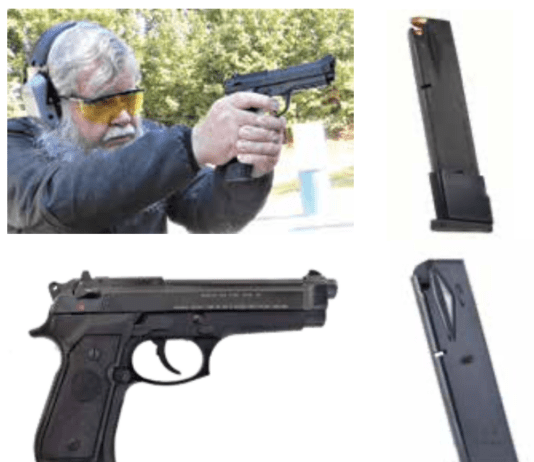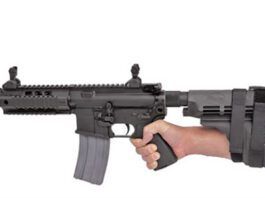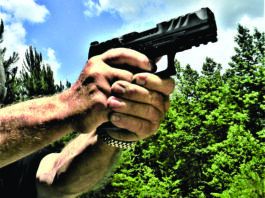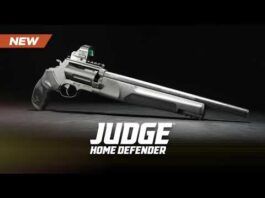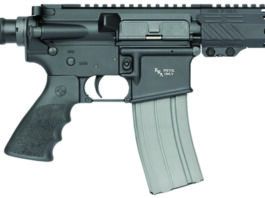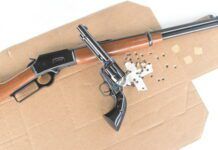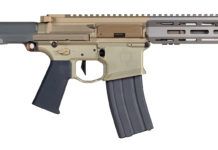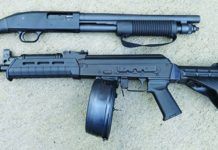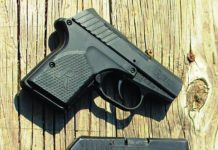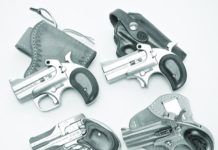New Shooter’s Guide: What Is a Pistol Caliber Carbine?
BATFE Reclassifies ‘Honey Badger’ AR Pistols as SBRs
Over-the-Counter Exotics from Mossberg and Century Arms
380 ACP Shoot Out: Ruger LCP Takes On Remington, Rock Island
New pistols chambered for the 380 ACP continue to flow out of factories because these generally smaller handguns feature reduced recoil firing the 9mm Kurz or 9mm Short, two other dimensionally accurate names for the 380 Auto cartridge. The 380's case is about 2mm shorter than the popular 9mm Luger case, though their bullet diameters are the same. The advantage of chambering ammunition with a short overall length helps keep these guns concealable.
One, the Ruger LCP, has sold in greater numbers than perhaps any other modern 380 ACP pistol, and with good reason, if the results in this magazine are any guide. In the June 2008 issue, we tested a just-released LCP and gave it an A- grade, saying of it, "This gun did what it was designed to do. Perhaps the grips could be more effectively textured, but we'd hate to spoil its looks. The Ruger LCP may be limited in its application, but could prove invaluable in its service." Head to head against the Kel-Tec P3AT, we said that Ruger had basically refined the Kel-Tec, in our view. The checkering on the slightly wider LCP grip frame was finer, which resulted in the Ruger jumping around in the hand more than the Kel-Tec. In that first look eight years ago, we narrowly preferred the Kel-Tec. Then in 2009, Ruger issued a recall for the LCP because the company had received a small number of reports that the gun, "...can discharge when dropped onto a hard surface with a round in the chamber." The company offered a retrofit of a different hammer mechanism to cure the problem, which was offered at no charge to the customer, and the little gun kept on chugging. In the February 2013 issue, we tested a variant of the LCP, the Ruger LCP-LM No. 3718, which mashed together Ruger's tiniest pistol with LaserMax's trigger-guard laser sight. The laser was nicely integrated into the pistol. In that test, we noted, "the female tester in the group had a hard time racking the slide. As pistols get smaller they can be harder to use and operate." We also said, "More seasoned testers did not like that the slide did not lock open on the last shot, like it did with the SIG P238 and Walther PK380." That pistol earned a B+ grade, and Our Team Said, "The Ruger was the best choice for deep-conceal carry" in that test. Then in the October 2015 issue, we tested a Ruger LCP-C Custom No. 3740 against a Taurus Curve and gave the upgraded LCP-C an A grade, saying of it: "We found the Ruger LCP-C Custom to be reliable, accurate enough for personal defense, and compact enough for concealed carry and pocket carry. The sights and trigger are improvements over previous versions of the LCP. The Ruger's footprint is smaller than the Taurus, but the Ruger is lighter and developed more energy." So, clearly, this is a capable, consistent handgun that has survived nearly 10 years because of its merits — simple operation, light weight, reasonable shooting characteristics, and affordability.
Seeking to take some of the LCP's market share, Remington officially introduced the RM380 Micro at the 2015 NRA Annual Meetings and Exhibits. The RM380 is a double-action-only pistol with second-strike capability. It operates from a delayed blowback action and has an aluminum frame. Remington produced an unusual marketing angle for the gun, claiming its slide-racking force was very low. That was something we asked the test team to evaluate in particular.
Also introduced at the 2015 NRA Annual Meetings & Exhibits in Nashville was Armscor's Rock Island Armory Baby Rock 380 ACP 1911 51912, though it had been shown as a prototype as early as the summer of 2014. At introduction, Rock Island President and CEO Martin Tuason called the pistol a "mini 1911" and said it was a single-stack pistol with a seven-round magazine. We previously tested a similar concept (an 85% 1911) in Browning's Black Label 1911-380 in the September 2015 issue, giving it a B ranking. Also in that test was the smaller, but still 1911-style Kimber Micro Carry Advocate Brown, which got an A- grade and was much better in the pocket.
While we conducted accuracy testing with our standard three loads, combat firing and initial break in was accomplished with six different loads. In order of use, they were: Winchester USA 95-grain FMJs, HPR 90-grain JHPs, Fiocchi Shooting Dynamics 90-grain JHPs, Winchester Train & Defend 95-grain FMJs, Gorilla Ammunition 95-grain JHPs, and the Black Hills Ammunition 60-grain Xtreme Defense.
Initial firing was done with Winchester FMJ loads, then we poured more than 100 rounds through each pistol for reliability testing and during combat firing at 5, 7, and 10 yards. Here's how the Ruger LCP, the Remington RM380, and Rock Island Baby Rock did.
Bond Derringers, Cartridge Penetration and the Springfield M2 Bolt
We publish reader feedback every month to answer questions about last month's featured firearms. See what subscribers have to say about Derringer handguns, the Springfield M2 Bolt rifle, how bullets penetrate home materials and more.
Why did you not include a Bond Arms derringer in your shoot-out, or at least reference the earlier article? I think it's a better gun than either of the others (the DoubleTap and Cobra Enterprises guns were not in the 2002 article). It's very solidly made, stainless steel throughout, has easily interchanged barrel sets, and is comfortable to shoot with 38s and cowboy 44-40s. Optional grips are available that are longer and have rubber panels to further ease recoil. It's as safe as any very short gun, with a rebounding hammer and a simple crossbolt safety. In the 2002 article, you rated the Bond Texas Defender as "Our Pick" for Cowboy Action shooting, and the American Derringer 38 Special as a Conditional Buy for self-defense because it was a double-action design, unlike the model you tested here. Finally, I would guess that Bond Arms is the largest manufacturer of derringers in the country.

























